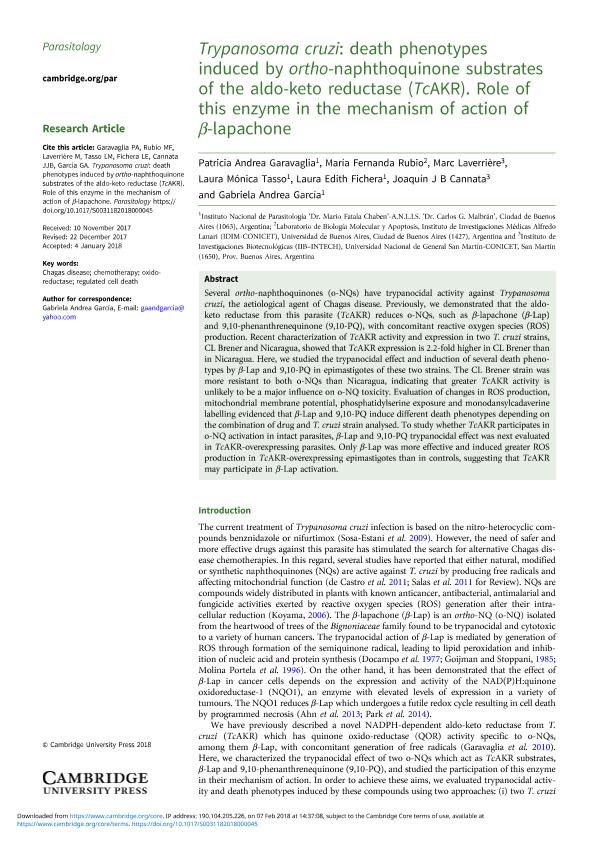Mostrar el registro sencillo del ítem
dc.contributor.author
Garavaglia, Patricia Andrea
dc.contributor.author
Rubio, Maria Fernanda

dc.contributor.author
Laverriere, Marc

dc.contributor.author
Tasso, Laura Mónica

dc.contributor.author
Fichera, Laura Edith

dc.contributor.author
Cannata, Joaquin Juan Bautista

dc.contributor.author
Garcia, Gabriela Andrea

dc.date.available
2019-10-21T20:11:50Z
dc.date.issued
2018-02
dc.identifier.citation
Garavaglia, Patricia Andrea; Rubio, Maria Fernanda; Laverriere, Marc; Tasso, Laura Mónica; Fichera, Laura Edith; et al.; Trypanosoma cruzi: Death phenotypes induced by ortho-naphthoquinone substrates of the aldo-keto reductase (TcAKR). Role of this enzyme in the mechanism of action of β-lapachone; Cambridge University Press; Parasitology; 145; 9; 2-2018; 1251-1259
dc.identifier.issn
0031-1820
dc.identifier.uri
http://hdl.handle.net/11336/86738
dc.description.abstract
Several ortho-naphthoquinones (o-NQs) have trypanocidal activity against Trypanosoma cruzi, the aetiological agent of Chagas disease. Previously, we demonstrated that the aldo-keto reductase from this parasite (TcAKR) reduces o-NQs, such as β-lapachone (β-Lap) and 9,10-phenanthrenequinone (9,10-PQ), with concomitant reactive oxygen species (ROS) production. Recent characterization of TcAKR activity and expression in two T. cruzi strains, CL Brener and Nicaragua, showed that TcAKR expression is 2.2-fold higher in CL Brener than in Nicaragua. Here, we studied the trypanocidal effect and induction of several death phenotypes by β-Lap and 9,10-PQ in epimastigotes of these two strains. The CL Brener strain was more resistant to both o-NQs than Nicaragua, indicating that greater TcAKR activity is unlikely to be a major influence on o-NQ toxicity. Evaluation of changes in ROS production, mitochondrial membrane potential, phosphatidylserine exposure and monodansylcadaverine labelling evidenced that β-Lap and 9,10-PQ induce different death phenotypes depending on the combination of drug and T. cruzi strain analysed. To study whether TcAKR participates in o-NQ activation in intact parasites, β-Lap and 9,10-PQ trypanocidal effect was next evaluated in TcAKR-overexpressing parasites. Only β-Lap was more effective and induced greater ROS production in TcAKR-overexpressing epimastigotes than in controls, suggesting that TcAKR may participate in β-Lap activation.
dc.format
application/pdf
dc.language.iso
eng
dc.publisher
Cambridge University Press

dc.rights
info:eu-repo/semantics/openAccess
dc.rights.uri
https://creativecommons.org/licenses/by-nc-sa/2.5/ar/
dc.subject
Chagas disease
dc.subject
chemotherapy
dc.subject
oxido-reductase
dc.subject
regulated cell death
dc.subject.classification
Bioquímica y Biología Molecular

dc.subject.classification
Ciencias Biológicas

dc.subject.classification
CIENCIAS NATURALES Y EXACTAS

dc.title
Trypanosoma cruzi: Death phenotypes induced by ortho-naphthoquinone substrates of the aldo-keto reductase (TcAKR). Role of this enzyme in the mechanism of action of β-lapachone
dc.type
info:eu-repo/semantics/article
dc.type
info:ar-repo/semantics/artículo
dc.type
info:eu-repo/semantics/publishedVersion
dc.date.updated
2019-09-30T19:14:54Z
dc.journal.volume
145
dc.journal.number
9
dc.journal.pagination
1251-1259
dc.journal.pais
Reino Unido

dc.journal.ciudad
Cambridge
dc.description.fil
Fil: Garavaglia, Patricia Andrea. Dirección Nacional de Instituto de Investigación. Administración Nacional de Laboratorio e Instituto de Salud “Dr. C. G. Malbrán”. Instituto Nacional de Parasitología "Dr. Mario Fatala Chaben”; Argentina
dc.description.fil
Fil: Rubio, Maria Fernanda. Consejo Nacional de Investigaciones Científicas y Técnicas. Oficina de Coordinación Administrativa Houssay. Instituto de Investigaciones Médicas. Universidad de Buenos Aires. Facultad de Medicina. Instituto de Investigaciones Médicas; Argentina
dc.description.fil
Fil: Laverriere, Marc. Consejo Nacional de Investigaciones Científicas y Técnicas. Centro Científico Tecnológico Conicet - La Plata. Instituto de Investigaciones Biotecnológicas. Universidad Nacional de San Martín. Instituto de Investigaciones Biotecnológicas; Argentina
dc.description.fil
Fil: Tasso, Laura Mónica. Dirección Nacional de Instituto de Investigación. Administración Nacional de Laboratorio e Instituto de Salud “Dr. C. G. Malbrán”. Instituto Nacional de Parasitología "Dr. Mario Fatala Chaben”; Argentina. Consejo Nacional de Investigaciones Científicas y Técnicas; Argentina
dc.description.fil
Fil: Fichera, Laura Edith. Dirección Nacional de Instituto de Investigación. Administración Nacional de Laboratorio e Instituto de Salud “Dr. C. G. Malbrán”. Instituto Nacional de Parasitología "Dr. Mario Fatala Chaben”; Argentina. Consejo Nacional de Investigaciones Científicas y Técnicas; Argentina
dc.description.fil
Fil: Cannata, Joaquin Juan Bautista. Consejo Nacional de Investigaciones Científicas y Técnicas. Centro Científico Tecnológico Conicet - La Plata. Instituto de Investigaciones Biotecnológicas. Universidad Nacional de San Martín. Instituto de Investigaciones Biotecnológicas; Argentina
dc.description.fil
Fil: Garcia, Gabriela Andrea. Dirección Nacional de Instituto de Investigación. Administración Nacional de Laboratorio e Instituto de Salud “Dr. C. G. Malbrán”. Instituto Nacional de Parasitología "Dr. Mario Fatala Chaben”; Argentina. Consejo Nacional de Investigaciones Científicas y Técnicas; Argentina
dc.journal.title
Parasitology

dc.relation.alternativeid
info:eu-repo/semantics/altIdentifier/url/https://www.cambridge.org/core/product/identifier/S0031182018000045/type/journal_article
dc.relation.alternativeid
info:eu-repo/semantics/altIdentifier/doi/https://doi.org/10.1017/S0031182018000045
Archivos asociados
